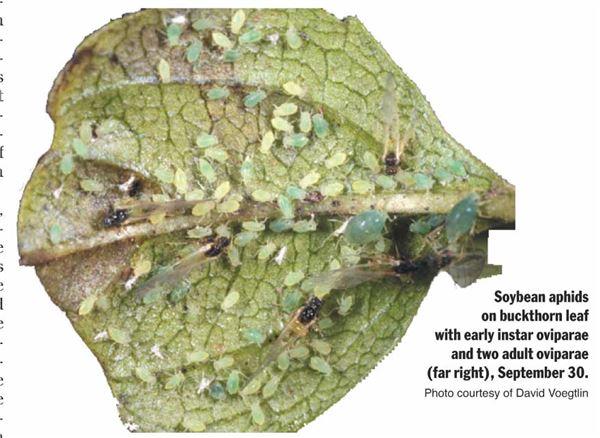Soybean Aphids Colonizing Buckhorn: Establishment Appears Solid
URBANA, ILL.
Soybean aphids are successfully colonizing buckthorn, their primary host, across central Illinois. Dr. David Voegtlin, longtime entomologist with the Illinois Natural History Survey and well-known authority on soybean aphids, indicates that establishment on buckthorn has been very good over the past 10 days. On September 27, he and some of his colleagues sampled a regional buckthorn grove in central Illinois and found soybean aphids on nearly all buckthorn plants. No multicolored Asian lady beetles were observed. Without the pressure of this natural enemy, we should anticipate a greater level of establishment of soybean aphids this fall.
As autumn sets in, winged soybean aphid females (gynoparae) are produced on soybeans (secondary host) as the photoperiod shortens and temperatures become cooler. These winged females must secure buckthorn plants to complete the sexual phase of the pest's life cycle. The overwintering hosts in North America include common buckthorn (Rhamnus cathartica L.) and the less-abundant alderleaf buckthorn (Rhamnus alnifolia L'Hér). After the winged females reach buckthorn plants in the fall, they feed and produce offspring that develop into oviparae. Winged males that have developed on soybeans also search out buckthorn plants, where the males mate with the oviparae. Eggs are subsequently produced and deposited on buckthorn plants and serve as the overwintering stage.

Dr. Voegtlin indicated that this year’s colonization, while impressive, is still not at the level of 2009, when buckthorn was inundated with soybean aphids. A fungal disease swept through the overcrowded aphid colonies, resulting in a very low overwintering density. This scenario seems unlikely for 2011 because the colonies on buckthorn are not quite as dense, and the overall relative humidity this fall has not been conducive to the development of fungal diseases. So despite the low densities of soybean aphids experienced by most producers this season, this insect appears to be setting the stage for a potential comeback in 2012. We obviously have a long way to go before the scenario unfolds.
I thank Dr. Voegtlin for sharing his observations and look forward to offering further reports on soybean aphids this fall and spring. Δ
DR. MIKE GRAY: Crop Sciences Extension Coordinator, University of Illinois